I had an interesting assignment last week for the Orange County (CA) Register. The University of Missouri – Kansas City hosts a choreography conference for a week each summer, and the Register had a writer covering it. They needed photos of the seven young choreographers who were attending, and the final performances. Sounded interesting, so I was happy to take the job.
The performances would start at 8pm, but I needed to see where I could shoot from and what the lighting would be like, plus I needed to do portraits (both individual and group) of the choreographers beforehand. I also wanted to meet with the people running the show, to explain what I needed and find out their restrictions. That meant I’d get there early, at 6:30.
The meeting with the organizers went great. They were happy to have the coverage, so had no trouble with me shooting from the back of the theater. I also got access to the balcony, which would give me a different angle for some shots. My goals on an assignment are always to make the client happy and try for something special. And part of making the client happy is to give them as wide a variety of photos as possible. That’s why the balcony was important. And I brought some extra gear because of that.
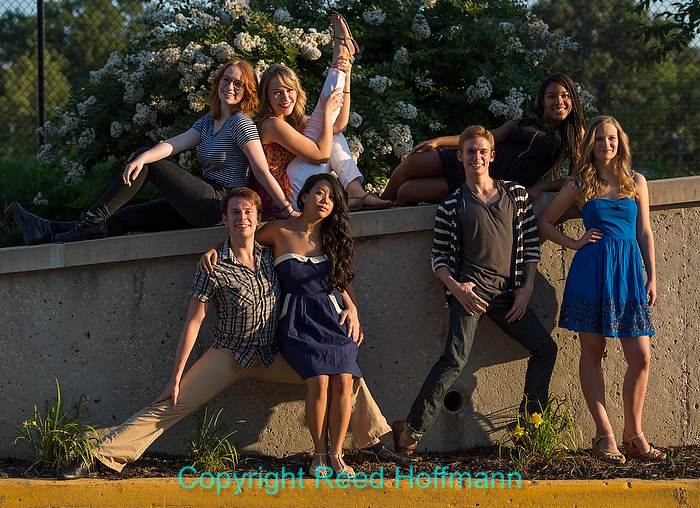
I liked this backdrop for the group shot, but the hard light made it challenging. Nikon D4 set to white balance of SUNNY and ISO of 200, shutter speed of 1/640 at f/5, with exposure compensation at -0.3, 70-200mm f/2.8 lens. Photo copyright Reed Hoffmann.
Next I needed to find a good place to do a group photo of seven people. I’ve learned that the more people in a picture, the harder it is to do something interesting. Getting a variety of different poses, and having everyone looking good at the same time becomes more challenging. In this case, though, I was looking forward to it. Working with choreographers, if they couldn’t find some nice poses, who could? So my main concern became finding a good location for the picture. I ended up with two. One safe, one more risky. By risky, I mean that the light was going to be hard. Contrasty light can be difficult to photograph people in, but can also be more visually interesting.
That risky spot was a sidewalk next to a retaining wall, with a bright yellow curb. The background was fairly clean, and that hard sidelight could bring some real “pop” to the picture. I told them I wanted three on the wall, and the others against it. My main
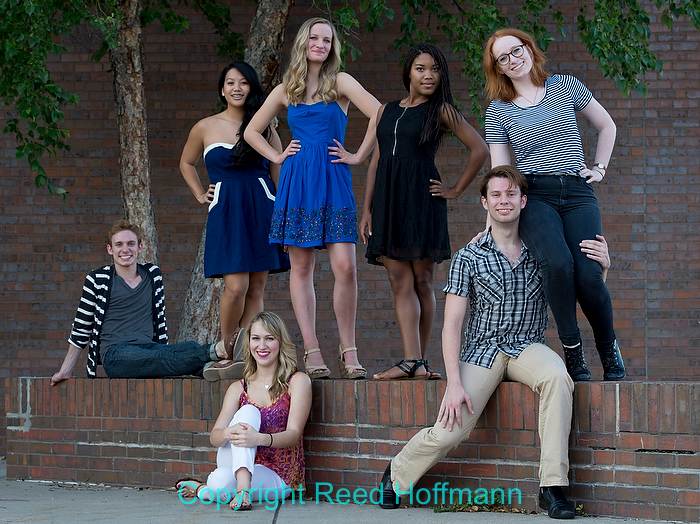
This was the “safe” spot for the group shot, with even light and a clean background. Nikon D4 set to white balance of SUNNY and ISO of 320, shutter speed of 1/100 at f/7.1, with exposure compensation at -0.3, 70-200mm f/2.8 lens. Photo copyright Reed Hoffmann
direction to them had to do with that sidelight. I explained that I needed everyone to turn their head slightly toward the light, and make sure their hair wasn’t shading their face. I was pretty happy with the resulting shot, although I hated the black metal pole in the upper left. If this was a commercial shoot I’d remove it in software. But since this was for a newspaper, that kind of manipulation is forbidden.
The safe shot was everything a safe shot is – even light and clean background. This time I took them across the street to another wall. This one was knee-high, coming out at an angle, about fifteen feet in front of a plain brick wall. Again, I asked a few of them to take low positions and the rest high. One trick to making a group shot more interesting is to vary not just their poses, but the height of their heads. Both locations worked well for that.
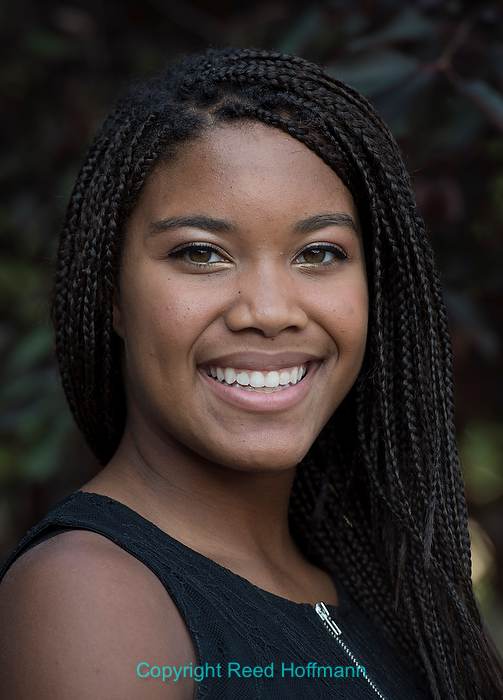
For most head shots, the goal is nice light and a non-distracting background. Nikon D4 set to white balance of SUNNY and ISO of 200, shutter speed of 1/160 at f/5, with exposure compensation at -0.3, 70-200mm f/2.8 lens. Photo Copyright Reed Hoffmann.
This was one of those times where getting there early and doing a little pre-planning really helps. They had performances to get ready for, so not a lot of time. By scouting the two spots ahead of time, I was able to do both pictures in about ten minutes. And after the group shots, I did a simple head-and-shoulders of each. Nothing fancy, just flat light and clean background, and using a telephoto with a fairly wide aperture to keep the background out of focus.
Then they headed in to prepare for the show, and I did too. For me that first meant checking on the lighting. Finding out that it would remain the same the entire evening, I got permission to hop up on stage and do a white balance pre-set with my gray card. Setting a custom white balance for both of my cameras meant I’d have no color problems to deal with later. Even though I was shooting RAW, this would save me time afterwards, not having to fix color. And while up there, I did an exposure test. If the light was staying at the same level, I just needed to find the right exposure. That way I could set both my cameras on Manual and not worry about exposure problems. Planning ahead for things like color and exposure can save a LOT of time at the computer later.
Now for my gear… Not knowing what I’d find, but knowing it was an indoor show, I brought cameras and lenses for low light. That meant my Nikon D4 as the primary camera because it excels at high ISOs. I also brought my D7100, both as a
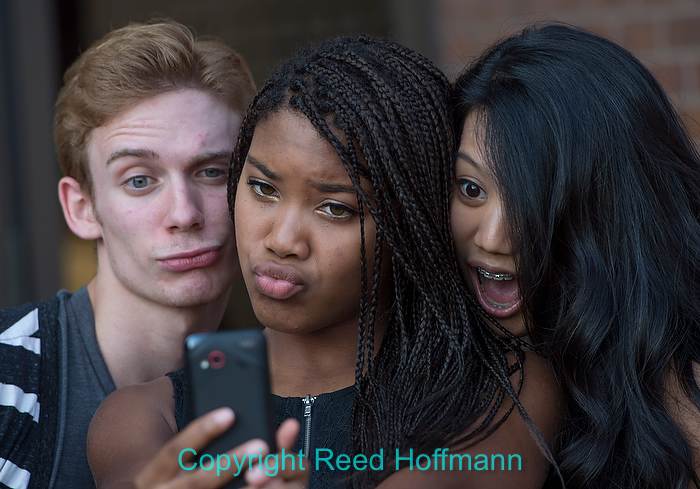
This shot of three of the choreographers taking a group picture of themselves is a good example of a candid moment. Nikon D4 set to white balance of SUNNY and ISO of 200, shutter speed of 1/250 at f/5, with exposure compensation at -0.3, 70-200mm f/2.8 lens. Photo copyright Reed Hoffmann.
second camera and a back-up. For lenses, I expected to be far away from the action, so in addition to the Nikon 70-200mm f/2.8, I brought along my 400mm f/2.8. For a wide-angle I brought the 16-35mm f/4. And just in case, I had the 85mm f/1.8. I also brought a tripod and a monopod. I planned on doing some slow-exposure blur shots, and would want the tripod for that. And the monopod would be needed for the 400mm. It’s a BIG lens, and I’m not that strong! As I mentioned, I had requested access to the balcony, so pre-positioned the tripod and 400mm up there.
Part of any newspaper assignment is looking for candid photos, un-staged, people getting ready, watching, etc. I managed to make a few of those, and they would be important for telling the story.
At 8pm the performances started. This conference is really a workshop, bringing young
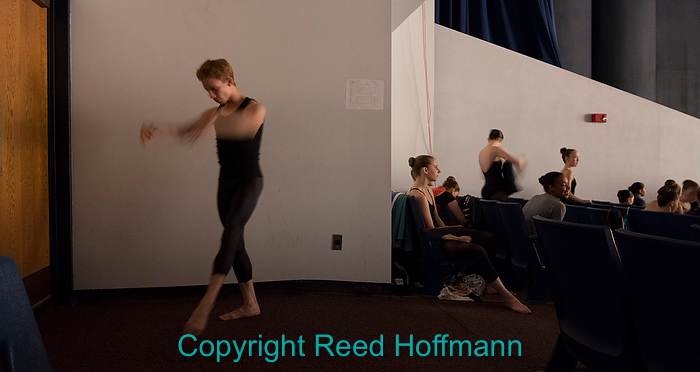
And this shot of one of them preparing for his performance is another nice candid moment. Nikon D7100 set to white balance of PRESET1 and ISO of 2500, shutter speed of 1/8 at f/4, with exposure compensation at -1.0, 16-35mm f/4 lens. Photo copyright Reed Hoffmann.
choreographers from around the country together to challenge them and grow their skills. Each day they’d be given an assignment, and have the afternoon to create a dance with some of the several dozen dancers also at the workshop. Each performance is just a few minutes long, and there’s little in the way of costumes. My only real complaint was the background – just the white wall behind the stage, complete with a few large vents. So while shooting I tried to keep them out of as many photos as I could.
It’s always tough shooting a play or dance you haven’t seen before, because you don’t know what’s going to happen. The key to any action photography is anticipation. If you push the shutter button when you see the action you want, you’ll be too late. Fortunately, I’ve been doing this a long time. And, most dances repeat moves, which helps a lot too.
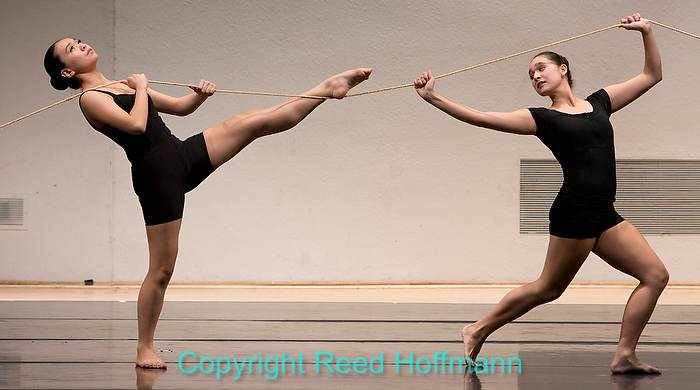
For the dance photos, I concentrated on interesting body position and tried to minimize the bad background. Nikon D7100 set to white balance of PRESET1 and ISO of 2000, shutter speed of 1/640 at f/4, with exposure compensation at 0.0, 70-200mm f/2.8 lens. Photo copyright Reed Hoffmann.
As I mentioned, variety is key. So I spent the next 90-minutes moving from the aisles to the back, and running up to the balcony. That gave me different angles and distances to work with, using all three of my main lenses. Never needed the 85mm, but I had it in case the light was REALLY low and I’d want that fast aperture.
With assignments like this, shooting is just part of the work, and sometimes the easier part. You also need to turn out the photos, and make sure they’re all captioned properly with everyone’s names. That started when I did the headshots of the choreographers. That gave me a good set of faces to work from to ID the candids and group shots. I also had a program of the dances, so made sure to shoot a blank frame between each dance. That way I could work through the shoot and know exactly what dance was being performed in each
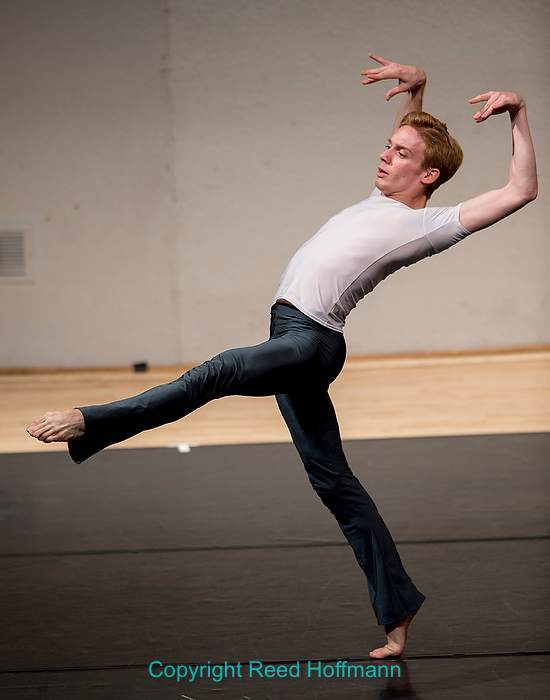
The 400mm lens let me shoot down from the balcony and still have fairly tight framing. Nikon D4 set to white balance of PRESET1 and ISO of 2000, shutter speed of 1/800 at f/4, with exposure compensation at 0.0, 400mm f/2.8 lens. Photo copyright Reed Hoffmann.
photo. That just left getting names for all the different dancers in the photos. Since I had a soft deadline (they aren’t publishing this story for over a week), I arranged with one of the organizers to have them provide ID’s of the dancers for me. To get that, I created a web gallery of those photos and sent them the link.
Returning home that night, I first downloaded the images from both cameras into one folder using Photo Mechanic (Camerabits.com). Then I sorted them by capture time (this is one reason it’s good to make sure all your cameras are set for the same date and time). After that I quickly looked through the images, marking all that had any possible future. At which point I deleted all the rest. When there’s a lot of action like this, I always expect to shoot a LOT of pictures, and won’t need all of them. I shot over 700 frames that night, but after that quick edit, was down to about half that number. Next step was to re-name them with the date and one word plus a sequential number. For example, the name of one of the shots from that night is “20130731_Choreog_032.NEF.” Then I went through the shoot a bit slower, and marked the ones I planned to deliver. Since this was going to be a large number of pictures (around 40), I then copied those “selects” to a different folder, and imported them into Adobe Lightroom.
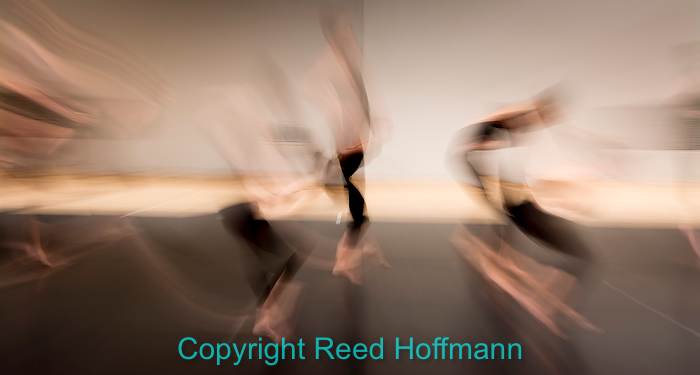
Variety in photos is important. I brought along a tripod so I could do some slow-exposure shots and try for interesting blur. Nikon D7100 set to white balance of PRESET1 and ISO of 100, shutter speed of 1/2 at f/11, with exposure compensation at 0.0, 70-200mm f/2.8 lens. Photo copyright Reed Hoffmann.
I know a lot of people use Lightroom for most of their photography. I’m not one of those. I use Photo Mechanic as my download/browse/sort tool, and usually prefer to work individual pictures with Nikon’s Capture NX 2 software. Sometimes I’ll use Photoshop, if I need the layers it offers. And I use Lightroom when I’ve done a big shoot and have to turn out a large number of images quickly. And don’t need the fine, detailed editing work I can do easily in Capture.
With those images now in Lightroom, I could quickly work through them, straightening, cropping, adding a touch of contrast or lightening a face a bit (with the Adjustment Brush). When they’re all ready, I export them as full-resolution JPEGS (remember I shot and was working with RAW (NEF) files) to be able to transmit to the newspaper.

At the end of the night, the dancers and choreographers gathered on stage for the audience to shoot pictures, which made another nice moment. Nikon D7100 set to white balance of PRESET1 and ISO of 1250, shutter speed of 1/400 at f/4, with exposure compensation at 0.0, 70-200mm f/2.8 lens. Photo copyright Reed Hoffmann.
And that was that! More photos than newspapers normally ask for, but with seven choreographers each putting on at least two dances, the numbers added up quickly. I expect they’ll use a few in the daily paper, and the rest on their website. That’s been one nice benefit of websites for photographers – room for all the pictures the print edition can’t use.
I had a good time, saw some great dances and met a bunch of nice people. And, as always, I got to shoot pictures, one of my favorite things in the world. What’s next? Tonight I’m shooting the exterior of a frozen yogurt store. Maybe not as exciting as dance, but this is photography – who knows what will happen.

